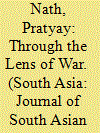| Srl | Item |
| 1 |
ID:
187227


|
|
|
|
|
| Summary/Abstract |
The Military Revolution debate has dominated histories of early modern warfare for over sixty years. This essay searches for new analytical avenues by charting the nature, causes, and implications of variations in Mughal warfare in early modern South Asia. It argues that a range of factors—including environmental conditions, military pragmatism, financial considerations, and distance from the imperial heartland—caused Mughal war-making to become heterogeneous over time and across space and produced variations in strategy, tactics, and deployment of technologies. These variations affected the broader processes of Mughal war-making and empire-building. This line of investigation bears potential to influence the writing of comparative military histories and the study of early modern warfare while looking beyond the Military Revolution framework.
|
|
|
|
|
|
|
|
|
|
|
|
|
|
|
|
| 2 |
ID:
159381


|
|
|
|
|
| Summary/Abstract |
The present article is a study of the process of Mughal empire-building in early modern North India using war as the point of entry. Specifically, it focuses on three sieges from the early years of Akbar's reign—Chitor (1567–68), Ranthambhor (1569) and Kalinjar (1569). It teases out certain aspects of these sieges and discusses them at length individually. Bypassing historiographically-popular themes like combat and technology, it explores less-probed issues such as the fate of defeated enemies, the involvement of zamindars and mansabdars, military finance and the role of quasi-military labour in imperial military campaigns. In the process, it strives to write a social, cultural and economic history of Mughal military expansion focused primarily on the second half of the sixteenth century.
|
|
|
|
|
|
|
|
|
|
|
|
|
|
|
|